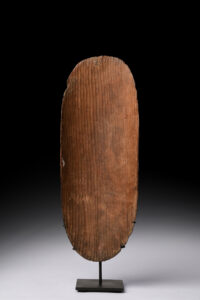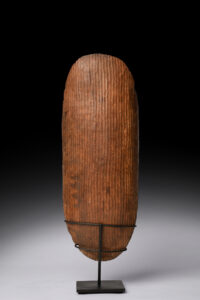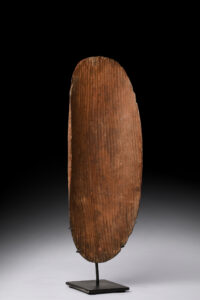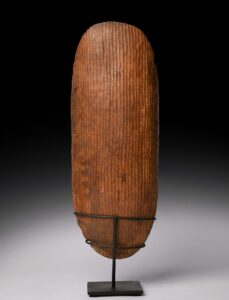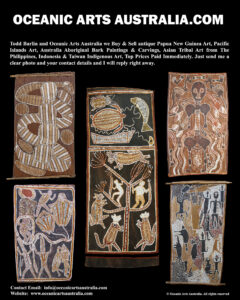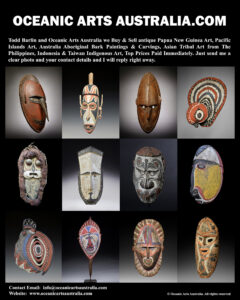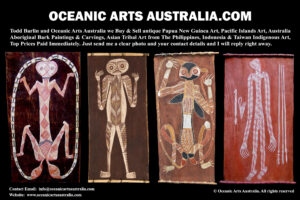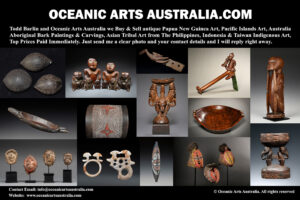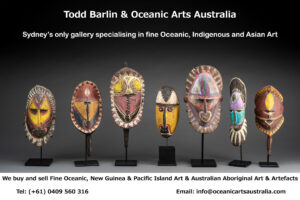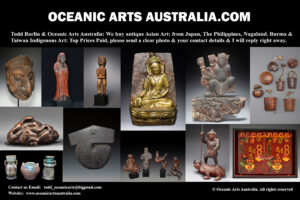A Superb Old Coolamon Bowl Central Australia 19th Century
| Collection No. | T-5571 |
|---|---|
| Size | 44.5cm |
A Superb Old Coolamon Bowl Central Australia 19th Century
This very fine beautiful old Coolamon is stone carved and is nearly perfect in every manner starting with the fine shape. The overall thickness of the bowl tapers slightly to the edges, the bottom of the bowl is convex as if it was made to sit gently in one’s hands or lap, and both sides of the bowl are finely incised with the same fluted designs. The whole bowl has a deep rich old patina from decades of daily use and traces of red ochre applied many times over long periods.
Coolamons were traditionally used by Aboriginal women to carry water, fruit, and nuts, as well as to cradle babies. Coolamons were often carried on the head when traveling any distance, or under the arm if used as a cradle. If carried on the head, a ring pad was placed on the head, made out of possum and or human hair string. This helped to cushion and support the carriage of the coolamon. The Pintupi of the Western Desert would attach a double strand of plaited rope made of hair or plant fibre to sling the coolamon over their shoulders. They also wore smaller coolamons as hats, with twine around the chin.
Coolamons were used for winnowing grains in the traditional bread-making process, as well as a general heating and cooking vessel. They could even be used as an umbrellas.
Coolamons were generally made by men. They are usually made from a hardwood such as mallee. A piece of the outer bark of the tree is removed and then molded over the fire to give it its distinctive curved sides. Deep ridges were made using a quartz stone knife. It needed to stand for several days, with a stick of wood holding it open to prevent it from losing its shape
Coolamons were often ornately decorated on their exterior with various designs. They were also used in ceremonies, such as for aromatic smoking, which was believed to have purifying effects.
They were rubbed regularly with fat, such as emu fat to keep the wood in good condition.
Provenance: The Tood Barlin Collection of Aboriginal & New Guinea Oceanic Arts
See my new EXHIBITIONS GALLERY showing the Museums and Art Galleries Exhibitions that I provided artworks for over the past 40 years. There is the link to the article about my artworks published in the prestigious Louvre Magazine in 1996
I have artwork for Museums and art Galleries but also for collectors at every stage of their collecting. I want to encourage people to explore the fine art of New Guinea & West Papua and the Pacific Islands and to be able to see and touch the artworks in a relaxed and friendly manner in my Sydney Gallery. I would like to invite you to visit my gallery and see the artworks in person and also look at my website www.oceanicartsaustralia.com where there are many Galleries & Sub Galleries to explore.
My Gallery of nearly 40 years is the last physical gallery in Sydney that specializes in New Guinea and Oceanic Art. Sydney is very close to New Guinea & the Pacific Islands where all of these amazing artworks came from, Australia’s closest neighbors.
To see many more rare items and the finest masterpieces, please make an appointment with us to visit the gallery.
For all inquiries, please contact us

